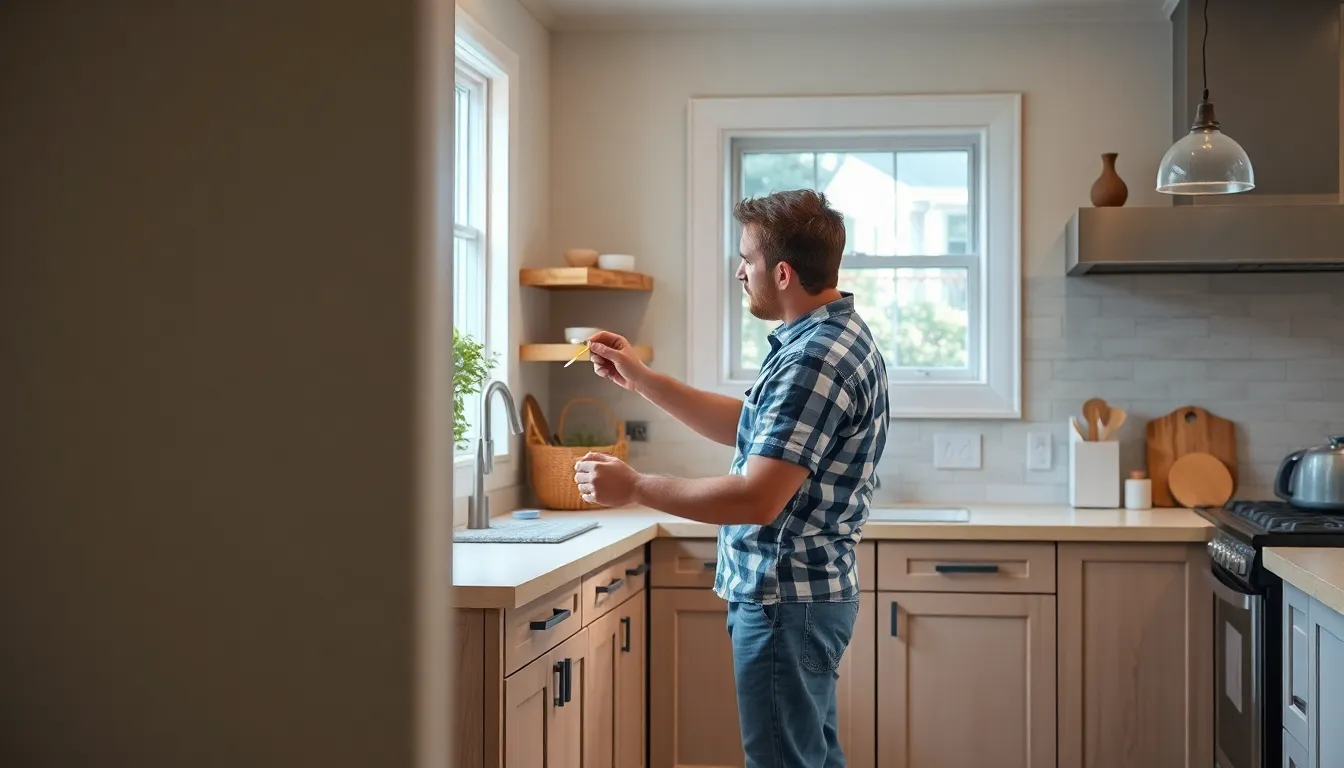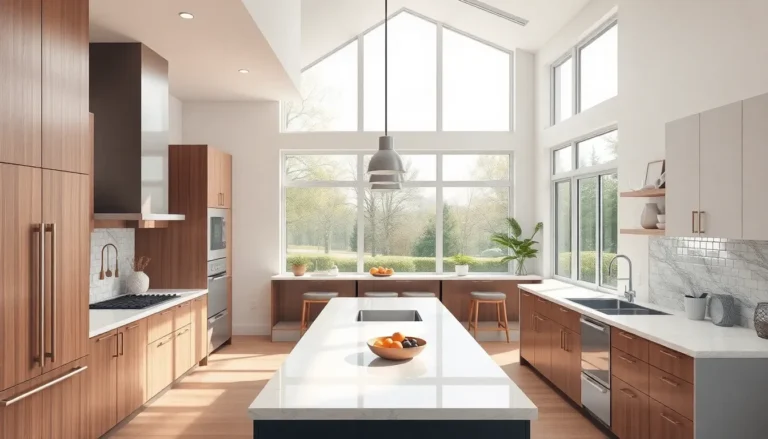Table of Contents
ToggleChoosing the right paint can feel like navigating a maze of colors, finishes, and fancy names that sound like they belong in a gourmet restaurant. With so many options out there, it’s easy to get overwhelmed. But fear not! Whether you’re looking to transform your living room into a serene oasis or create a bold statement wall that screams “look at me,” there’s a perfect paint option waiting just for you.
Overview of Paint Options
Choosing paint involves understanding various options available in the market. Paint types fall into categories based on their formulation, including latex, oil-based, and specialty paints. Latex paints dry quickly and emit fewer odors, making them ideal for interior spaces. Oil-based paints provide a smooth finish and are perfect for high-traffic areas, but they require longer drying times.
Finishes vary as well, each serving different aesthetic and functional purposes. Matte finishes create a soft look, perfect for low-traffic areas, while eggshell finishes strike a balance between sheen and durability. Satin finishes offer a slight gloss and are easier to clean, suitable for kitchens and bathrooms. Gloss finishes provide a reflective surface, ideal for highlighting architectural details.
Colors range extensively, allowing for customization tailored to individual tastes. Neutral shades contribute to a calming environment, while bold hues can energize a room, serving as design focal points. Color trends shift over time, often influenced by interior design movements and cultural phenomena.
Preparation plays a crucial role in achieving the best results. Proper surface cleaning and priming ensure better paint adherence and longevity. Tools, such as brushes, rollers, and sprayers, influence application efficiency and finish quality.
Each option presents unique characteristics tailored to specific needs. Identifying the right combination of type, finish, and color aligns with one’s design vision while addressing functional requirements. Exploring these options leads to informed decisions that enhance any living space.
Types of Paint

Choosing the right type of paint significantly influences the final look and durability of a painting project. Several options exist, including water-based, oil-based, and specialty paints.
Water-Based Paint
Water-based paints, often referred to as latex paints, provide a user-friendly experience. They dry quickly, typically within one to two hours, and produce less odor, making them ideal for indoor applications. These paints clean up easily with soap and water, promoting convenience. Many homeowners prefer water-based paints for their versatility and ease of application on surfaces like drywall and wood. Additionally, they maintain color for extended periods and offer good adhesion on various surfaces.
Oil-Based Paint
Oil-based paints offer unique advantages that cater to specific needs. They create a smooth, durable finish, making them perfect for high-traffic areas like kitchens and bathrooms. Drying time usually spans six to eight hours, requiring careful planning. The enhanced durability and resistance to wear make oil-based paints suitable for wood trim and cabinets. Cleaning brushes and tools requires solvents like mineral spirits, which adds to the maintenance aspect. Despite a stronger odor, these paints remain a favored choice for those seeking a polished, long-lasting result.
Specialty Paints
Specialty paints excel in fulfilling particular needs and unique designs. These include chalk paints for a vintage finish, magnetic paints for functional walls, and even anti-mold formulas for damp areas. Specific brands may provide textured options, enhancing visual appeal and depth. Specialty paints often require special application techniques, emphasizing the importance of following manufacturer guidelines for best results. With a variety of applications, these products serve as valuable tools for achieving creative goals and practical benefits.
Paint Finishes
Paint finishes play a crucial role in both aesthetics and functionality of a space. Each finish brings unique properties that cater to different needs.
Matte Finishes
Matte finishes offer a non-reflective surface that absorbs light, creating a soft and sophisticated look. They work well in low-traffic areas, like bedrooms or hallways, where durability is less of a concern. Choosing matte for walls hides imperfections, providing a smooth appearance. This finish, however, doesn’t resist stains well, making it less ideal for high-use spaces. Cleaning will often require gentle touchups, as scrubbing can damage the surface.
Gloss Finishes
Gloss finishes provide a high-shine surface that reflects light, enhancing brightness in any area. Glossy paints are particularly resilient, making them suitable for high-traffic areas, such as kitchens and bathrooms. This finish is easy to clean, as it withstands scrubbing and moisture effectively. Its reflective property can help with small space illusions, making rooms feel larger and more open. When used thoughtfully, gloss finishes add a striking touch to architectural details like trims or moldings.
Satin Finishes
Satin finishes strike a balance between gloss and matte, offering a subtle sheen that is both elegant and functional. They are highly adaptable, making them ideal for versatile spaces like living rooms and family rooms. Their durability stands out, as satin can resist stains while remaining easy to clean. This makes satin finishes a popular choice for busy households. The soft glow they emit provides a warm atmosphere while still allowing for easy maintenance of surfaces.
Factors to Consider When Choosing Paint
Selecting the right paint includes several key factors to ensure satisfaction and durability.
Color Selection
Choose colors that enhance both mood and design of the space. Neutral colors often create calm environments in bedrooms and living rooms. Bold colors, however, can energize areas like playrooms or home offices. Consider the lighting; natural light may soften colors during the day, while artificial light can alter their appearance at night. Use paint samples on walls to visualize the impact. Test colors in pre-existing furniture and décor to guarantee harmony throughout the room.
Durability and Maintenance
Durability influences the longevity of the paint finish. High-traffic areas like hallways and kitchens typically benefit from durable finishes that withstand wear and tear. Gloss and satin finishes resist stains and scratches better than matte options. Maintenance should also factor into the decision; easy-to-clean surfaces save time and effort. Regular touch-ups manage wear in areas that attract dirt and grime. Investing in high-quality paint often leads to better results and reduced maintenance.
Environmental Impact
Environmental considerations are increasingly significant in paint selection. Opt for low-VOC or zero-VOC paints, which reduce harmful emissions and improve indoor air quality. Sustainable options highlight eco-friendly ingredients and packaging. Research brands’ production practices to assess their commitment to sustainability. Consider how the paint choice influences both personal health and the planet’s well-being. Choosing environmentally conscious products leads to healthier living spaces without sacrificing quality or aesthetics.
Choosing the right paint can transform a space and enhance its overall appeal. With a variety of formulations and finishes available it’s possible to find the perfect match for any room. By considering factors like color impact durability and environmental considerations readers can confidently navigate their options.
Testing samples and understanding the importance of preparation can lead to a successful painting project. Ultimately the right paint choice not only elevates design but also supports a healthier living environment. Embracing these insights empowers individuals to create spaces that reflect their personal style and meet their functional needs.




